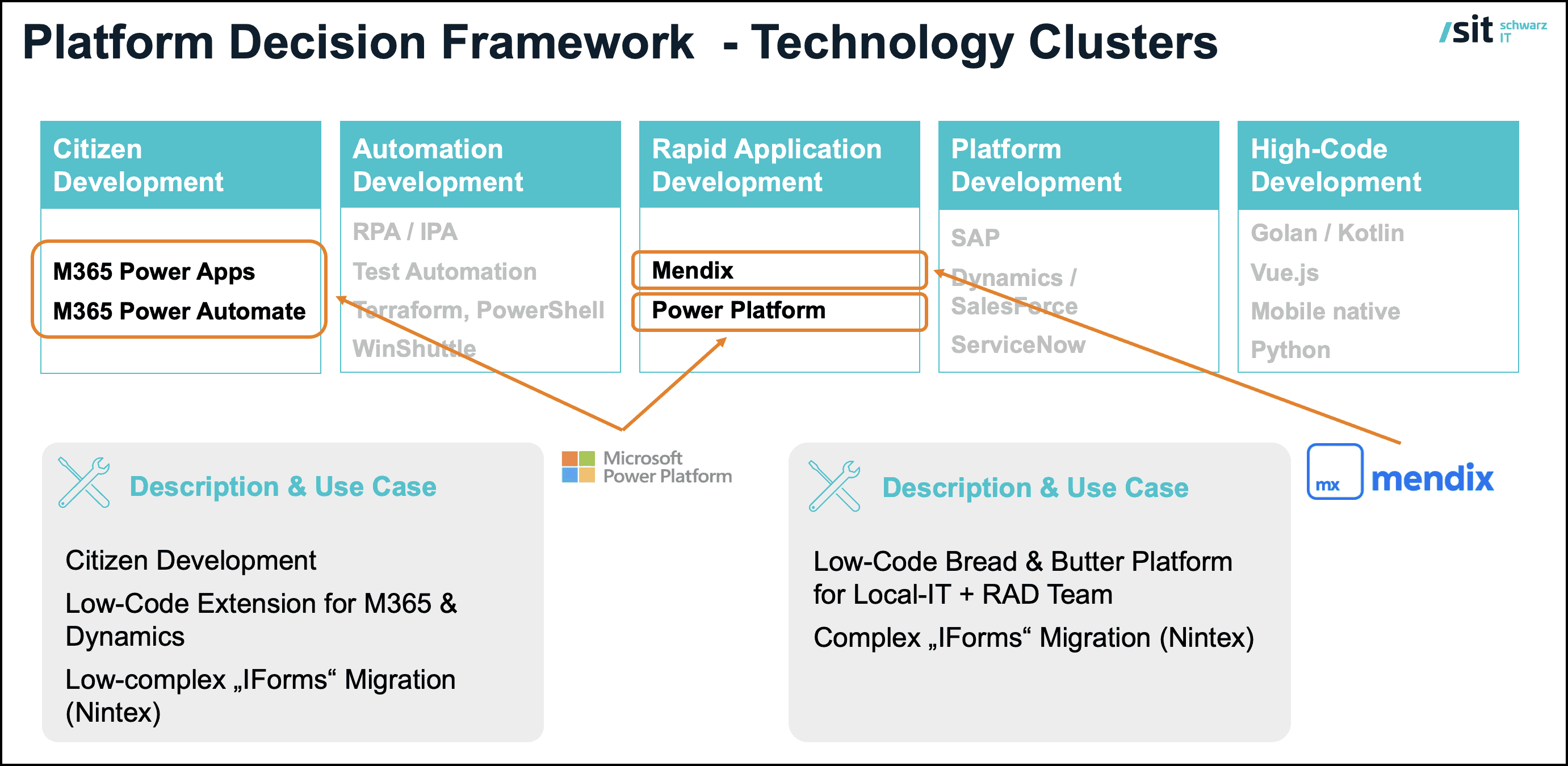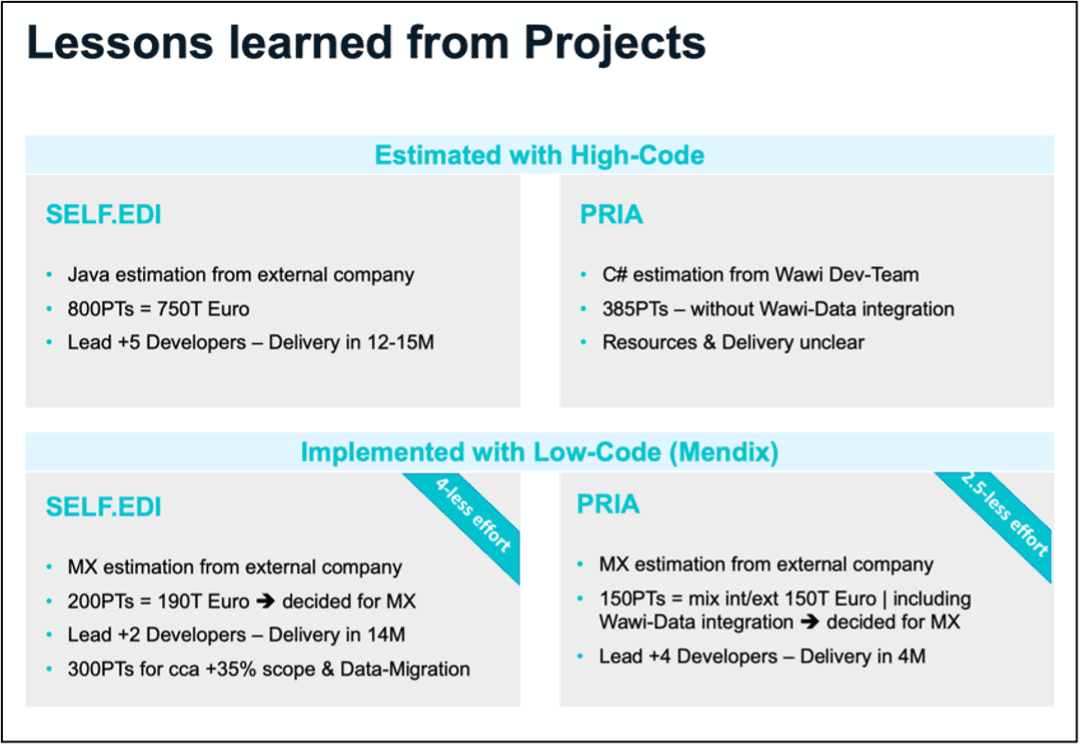How to Decide Between Mendix and Microsoft Power Apps for Software Delivery

Whether it’s high-code, low-code, or off-the-shelf products, most IT leaders will tell you there is never a silver bullet to solve complex enterprise challenges.
Low-code comes in a wide range of flavors. It can be used in the context of a SaaS to attach screens and workflows to a database, or to build more complex enterprise software that bridges data sources and systems of record.
Enterprise IT strategy is synonymous with multi-platform strategy. In the case of low-code, the question is shifting from “this or that” to “what and when”?
In a recent Mendix webinar Zdenek Prochazka, Leader of Rapid App Development at Schwarz IT, detailed his organizations’ parameters for leveraging both Mendix and Microsoft Power Apps.
Ask the Right Questions
Schwarz IT has tailored their development strategy to fit the needs, complexity, and use cases of their organization.
Their exact implementations may differ – but both start with addressing a series of similar questions to determine when to use what platform:
- WHY are you leveraging low-code platforms to begin with, or rather, what is your vision?
- WHO is intended to develop the solution within your organization?
- WHAT types of use cases and complexity are you trying to address with low-code?
Find Your Why
Schwarz IT services Schwarz Group, the parent company to two of Europe’s most-recognizable grocery brands – Lidl and Kaufland. The Schwarz Group was in need of a new mode of software delivery to support their local teams whose solution demands often couldn’t be met by global IT.
“The best approach starts with a clear understanding of where you are and where you want to go,” said Prochazka. “Your IT strategy should be based on the inputs and trends that are important for you as a company. In our case, this was in agility, cloud transformation, the stability of solutions, and – this may be very specific to Schwarz – sovereignty.”
Prochazka shared that Schwarz IT had a desire to empower citizen developers and business collaborators in the software development lifecycle, and thus the need for low-code platforms was identified.
Standardization, democratization, and reuse are priorities in selecting low-code or no-code tools of choice, with platform users and use-cases defining which to use when.
Who Develops Solutions?
Today Gartner identifies more than one group of individuals who can contribute directly to software development:
- Citizen developers, who report in to a business function and have little to no technology background
- Business technologists, who also report into a business function but have technology expertise and can contribute to the SDLC with greater impact
- And of course, professional developers, or those who have extensive career knowledge with technology and software development
For Schwarz IT the distinction of who does the development draws a clear line between the use cases for Mendix or Power Apps.
Prochazka describes clear parameters for what an appropriate citizen development project is.

“We decided to support citizen development with well-defined guidelines and scope for non-professional developers… This is where we decided to go for the Power Platform,” he said.
Citizen development projects often fall into the category of adding a simple screen or workflow that can exist within the Microsoft ecosystem.
Mendix provides the same low barrier to entry for other contributors in the SDLC. However, it is most impactful when used by business technologists or professional developers to build sophisticated, complex applications within a structured software development process.
“We decided to use Mendix as a professional development tool following the DevOps principles and quality requirements comparable to, for example, SAP, or high-code standards,” he added.
What Will You Develop?
A final prompt in determining the best fit for a Mendix or Power Apps project in your IT landscape is by use case complexity. Indicators of complexity can include:
- Types or volume of integrations
- Mobile applications
- Volume of end-users

“Maybe you want to use low-code as an extension for other solutions like SAP. These are good points of departure to determine which platform you need,” he shared.
Mendix is often regarded as a strong platform where integration with other systems, particularly SAP, is a requirement, where Power Apps operates well within the Microsoft ecosystem.
“We like to use the Power Platform as an extension for integrated products like Microsoft 365 or Dynamics, or maybe small form solutions,” he added.
Device operability is another area where Schwarz has seen the two platform’s capabilities on display.
“The UI in Power Apps is really optimized on selected templates. When you do this for a browser or iPhone, then you typically have to build a minimum of two or maybe even three UIs to ensure a nice user experience with the application,” said Prochazka.
“Regarding Mendix, we have had a good experience with progressive web apps… The HTML side is working very nice and could run on Android or iOS devices very smoothly.”
Lastly, the size of the application or project helps categorize their decision-making. Solutions defined as simple applications that fit the aforementioned criteria often fit best with Power Apps. Small, mid-size, and large business applications with moderate to high complexity can be a better fit for Mendix.
With Mendix, this caliber of solution can be delivered from start to finish in a single platform. Achieving the same level of complexity within the Microsoft suite may require piecing a solution together with many tools like Power Apps and Power Automate.

In Schwarz’s case, Mendix shines when used for projects of medium criticality and moderate to high complexity. This includes Nintex forms migrations, or PRIA, an application that manages the workflow of addressing recalled products in Schwarz’s grocery stores.
Prochazka shares that other KPIs are estimated at the project onset – such as the level of effort, volume of business processes, or volume of stakeholders – come into play, as they will also “inform the complexity or criticality of the project at the end.”
“With more than two years of driving coexistence with the Power Platform and Mendix in our portfolio, we feel confident in our recommendations. First, that Power Apps is great for citizen development or smaller professional developments in the Microsoft ecosystem like M-365 or Dynamics 365 CRM,” said Prochazka.
Remain Open to Change
It’s important to consider where your organization sits in terms of development team expertise, cloud strategy, architecture, and low-code maturity when determining your decision tree for rapid application development platforms.
While the exact parameters for every organization will vary based on their specific needs, keep in mind that the platforms and your perspective will and should evolve over time.
“For us there are a lot of similarities in what is technically possible,” Prochazka said.
“This is what we learned with Mendix. It has many possibilities similar to high-code development. We started to learn from smaller projects to establish our maturity and didn’t go right for the most critical or difficult tasks in the beginning. But now we feel that we can do much more with Mendix in the future than we do today.”
